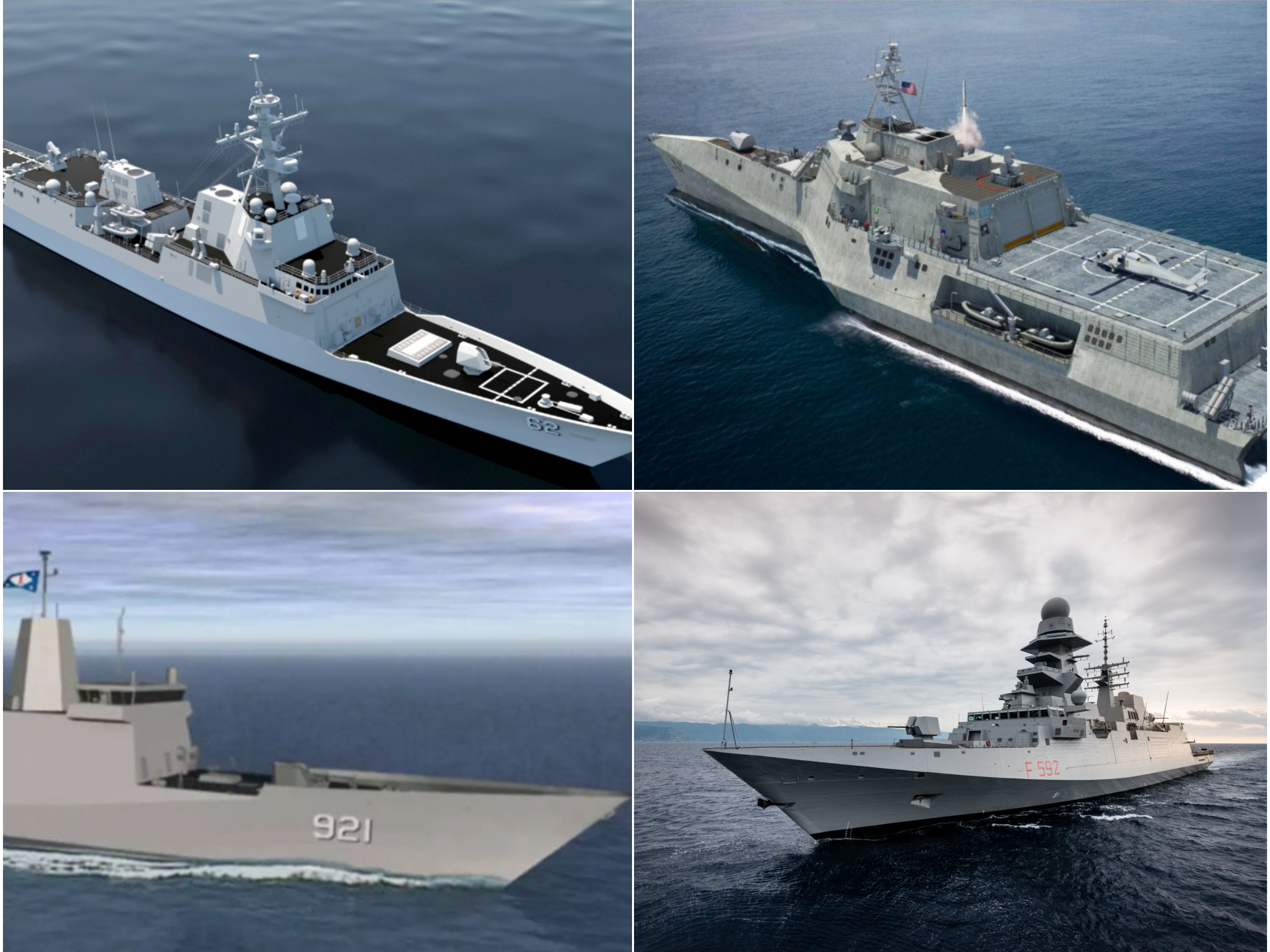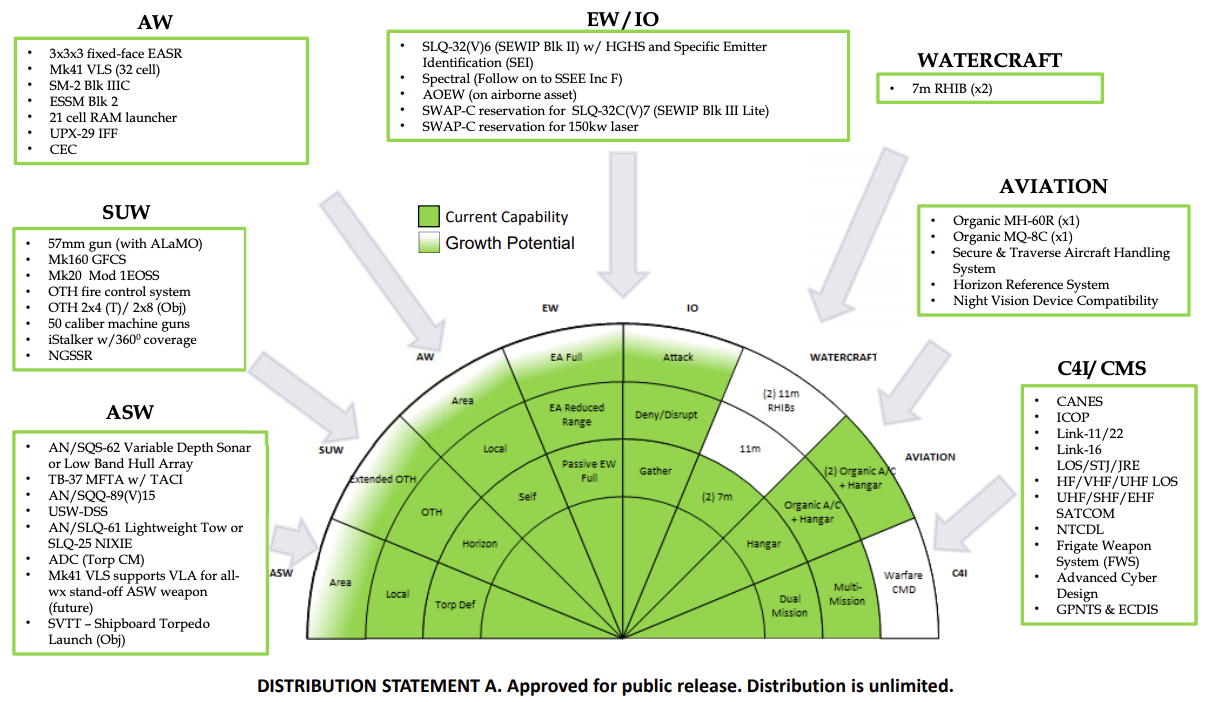
The Navy released the final request for proposals for its next guided-missile frigate (FFG(X)) today, outlining the program that will get the U.S. Navy into the business of operating high-end small combatants.
The service is counting on the new frigate to help the fleet operate in a distributed manner in a contested maritime environment. To that end, the final solicitation for bids for the FFG(X) program highlights a particular interest in what industry can offer in range; margins for weight, cooling, electrical and arrangeable deck area, to allow the ship to bring in new technologies as they develop; acoustic signature management; undersea surveillance; and over-the-horizon capabilities.
After previous iterations of the frigate were ditched as the Navy’s view of what capability it wanted evolved, the current FFG(X) effort sought to bring in industry early to ensure that requirements were in line with what technologies were currently feasible at the right price point. Those ongoing discussions led the Navy to settle on a ship that would have at least 32 vertical launching system (VLS) cells, an Aegis-based combat system, the Cooperative Engagement Capability datalink so the frigate could share targeting data with other ships and aircraft, and advanced anti-submarine warfare and electronic warfare systems.
The service announced earlier this year the frigate would include as government-furnished equipment:
- A fixed-face Raytheon Enterprise Air Surveillance Radar (EASR) that will serve as the primary air search radar.
- At least 32 Mark 41 Vertical Launch System cells that could field Standard Missile 2 Block IIICs or RIM-162 Evolved SeaSparrow Missiles (ESSM) and a planned vertically launched anti-submarine warfare weapon.
- COMBATSS-21 Combat Management System based on the Aegis Combat System.
- Cooperative Engagement Capability (CEC) datalink that would allow the frigate to share targeting information with other ships and aircraft.
- Space, weight and cooling for 8 to 16 Over-the-Horizon Anti-Ship Cruise Missiles
- An aviation detachment that includes an MH-60R Seahawk helicopter and an MQ-8C Firescout Unmanned Aerial Vehicle.
- AN/SQQ-89(V)15 Surface Ship Anti-Submarine Warfare (ASW) Combat System
- AN/SQS-62 Variable Depth Sonar.
- SLQ-32(V)6 Surface Electronic Warfare Improvement Program (SEWIP) Block 2 electronic warfare suite with allowances to include SEWIP Block 3 Lite in the future.
- Space, weight and cooling reservation for a 150-kilowatt laser.
Further highlighting the focus on allowing the ships to be upgraded as technology evolves, the solicitation asks that bids include a “description of the flexibility in the design to accommodate efficient warfare systems upgrades by explaining equipment removal and upgrade paths with an emphasis on avoiding hull cuts or the need for dry docking,” as well as provisions for upgrading hull-mounted and towed undersea warfare sensors.
Five industry teams have been involved in early design maturation efforts, which both helped industry refine their plans to be more in line with what the Navy wanted, and allowed the Navy to refine its idea of how much this new class might cost.

Earlier this year, USNI News reported that costs were coming down as a result of the design maturation contracts.
“$950 (million) was the threshold; $800 million is the objective,” frigate program manager with Program Executive Office Unmanned and Small Combatants Regan Campbell said in January at the Surface Navy Association symposium.
“We started closer to the $950; we are trending to very close to the $800 now. We have taken some very significant costs out,” she said of the second through 10th ship of the class. The Navy intends to buy at least 20 frigates, though the first contract will only cover the first 10. After the first contract, the Navy could continue with the same builder or re-compete the program to potentially bring in a second builder, if it wanted to accelerate frigate production to keep in line with its drive to reach a 355-ship fleet and leadership acknowledgement that it will need more small combatants and fewer high-end destroyers going forward.
After the release of today’s final RFP, interested bidders will have until Aug. 22 to submit their technical proposals to the Navy and until Sept. 26 to submit their pricing proposal. A winner will be selected in Fiscal Year 2020 to build the frigate.
Of the five companies that participated in the design maturation phase, four are expected to submit bids to the RFP. Austal USA, who builds the Independence-variant Littoral Combat Ship; Fincantieri Marine, which builds the Italian FREMM multipurpose frigate; General Dynamics Bath Iron Works, who will partner with Spanish F100-builder Navantia; and Ingalls Shipbuilding, who has declined to discuss its design, all worked with the Navy to take their existing parent designs and mature them to become in line with the Navy’s vision for its guided-missile frigate. Lockheed Martin, which builds the Freedom-variant LCS, was part of that effort as well but announced it would not continue on with the frigate competition.
Despite the earlier design work that the Navy funded, the frigate competition is open to any bidder who has a parent design to base the frigate offering on.





